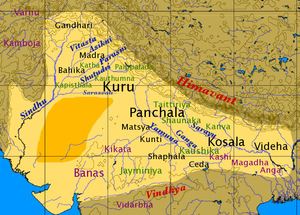- Āryāvarta
-
Āryāvarta (Sanskrit: आर्यावर्त, "abode of the Aryans") is a name for Northern India in classical Sanskrit literature. The Manu Smriti (2.22) gives the name to "the tract between the Himalaya and the Vindhya ranges, from the eastern to the Western Sea".
The Vasistha Dharma Sutra I.8-9 and 12-13 locates Āryāvarta to the east of the disappearance of the Sarasvati in the desert, to the west of Kalakavana, to the north of the mountains of Pariyatra and Vindhya and to the south of the Himalaya. Baudhayana Dharmasutra (BDS) 1.1.2.10 gives similar definitions and declares that Āryāvarta is the land that lies west of Kalakavana, east of Adarsana, south of the Himalayas and north of the Vindhyas, but in BDS 1.1.2.11 Āryāvarta is confined to the Ganges - Yamuna doab, and BDS 1.1.2.13-15. Patañjali's Mahābhāṣya[citation needed] defines Āryāvarta like the Vasistha Dharma Sutra.
Some sutras recommend expiatory acts for those who have crossed the boundaries of Āryāvarta. Baudhayana Shrauta Sutra recommends this for those who have crossed the boundaries of Āryāvarta and ventured into far away places.[citation needed]
The Gurjar Pratihar king in the tenth century was entitled as Maharajadhiraja of Aryavarta.[1]
References
Bibliography
- Kane, Pandurang Vaman: History of Dharmasastra: (ancient and mediaeval, religious and civil law) Bhandarkar Oriental Research Institute, Poona (1962–1975)
See also
Categories:- History of Hinduism
- Locations in Hindu mythology
- Eurasian nomads
Wikimedia Foundation. 2010.

